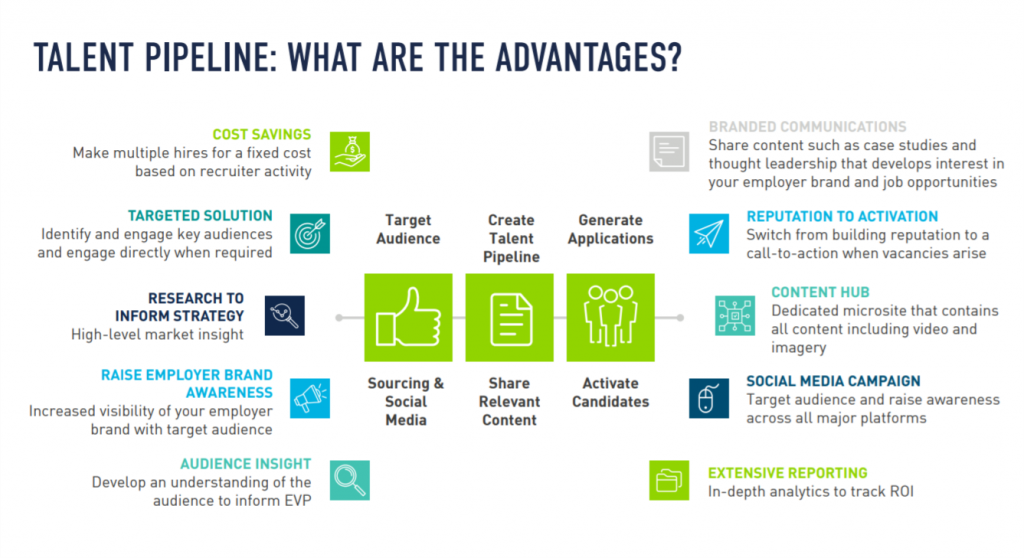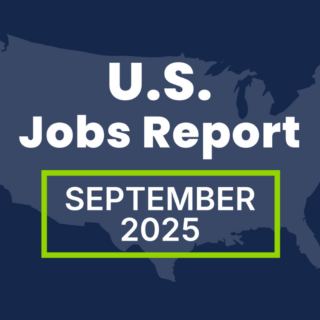As we return to work, resiliency, business continuity and recovery are fast emerging as critical priorities for business leaders. Creating a talent pipeline strategy for vital roles is one way organizations can build greater resilience, have clear succession plans and ensure talent continuity. However, with hiring freezes and uncertainty around when hiring will resume has left many talent teams in limbo.
That said, there has never been a more important time to focus on building your talent pipeline strategy to ensure you have the best possible talent on your team and are well-positioned as things return to normal. You may not have positions to fill now, but by building a robust talent pipeline now, you will place yourself in a better position when we return to business as usual.
In this article, we cover how to build a better talent pipeline and engagement strategies and best practices for building stronger relationships with your candidate pool.
What is a Talent Pipeline?
A talent pipeline is a proactive talent acquisition strategy that seeks to identify, engage and recruit talent to build a robust pool of candidates to fill roles as needed. Similar to a sales funnel where leads progress through multiple stages of engagement and are eventually converted into clients, a talent pipeline moves potential job candidates through engagement stages that hopefully lead to making a hire. Like most modern recruitment practices, talent pipelining has been derived from proven sales and marketing strategies.

With a talent pipeline, organizations can pick and choose from a highly qualified group of candidates who are already familiar with the organization. The key to a successful talent pipeline strategy lies in candidate engagement because recruiting teams are not focused solely on filling open roles. Rather, they are thinking about how to best meet future talent needs through building better relationships with top talent. In addition to better candidates, talent pipelining allows you to diversify your talent pool, deliver personalized candidate experiences and improve your overall employer brand.
How to Build a Pipeline of Candidates: Talent Pipeline Strategy and Engagement Starts with Your Employer Brand

Talent pipelining is about influencing candidate behavior, so the first and most logical place to begin when creating a talent pipeline is the answering the following questions:
- How do you generate interest in your organization?
- What differentiating factors set your organization apart from other employers?
- Why should candidates choose to work for your organization?
To find the answers to these questions, you need to turn to your employer brand. In a talent market that’s reeling from the effects of a global pandemic and calls for increasing racial diversity, your reputation as an employer is now more important than ever to attract high-quality candidates.
What’s more, at a time when candidates can quickly look up information about your organization, from compensation and benefits to the work culture and advancement opportunities, building a strong employer brand is paramount. In fact, according to the Harvard Business Review, a negative employer reputation can costs organizations up to 10% more per hire.
To attract and bring top talent to your organization’s talent pipeline, maintaining and personalizing your candidate-facing content should be a top priority. You can achieve this by improving the content on your careers page and in your social media outreach with high-quality resources, guides, videos.
So, how do you position yourself as an employer of choice in your industry and fill your talent pipeline with qualified talent? Below are some simple steps that can help you get started:
Leverage Your Career Site
The first place many candidates will engage with your employer brand will be through your career site. Use your career site to highlight your corporate values, culture and provide a real glimpse of what life for the employees of your organization is like.
Make sure that your employer brand messaging on your career site is consistent with that on your social media channels, company website and review pages such as Glassdoor and Indeed. Also, make sure your career site is mobile optimized as many mid-career professionals are more likely to search for opportunities on their mobile devices. The easier it is to apply and interact with your organization, the more top candidates you will be able to add to your pipeline.
Candidate Engagement Best Practices: Engage Your Talent Pipeline on Social Channels
Social media has fast become a top recruitment marketing channel. Moreover, according to Glassdoor, 79% of job applicants use social media in their job search, so engaging with candidates and presenting a positive employer brand on social media is essential.
For example, you can build a stronger employer brand and engagement with your target audience by promoting authentic conversations about life within your organization and asking candidates to share what they seek in an employer. You should also celebrate employee achievements, share real-life stories, photos and videos to show potential candidates what it is like working with you. This will make it more likely that candidates will feel comfortable applying for positions at your organization.
Your Employees Are Your Best Advocates
Building on your social media strategy, you can also look at employee advocacy as an effective branding and talent pipeline building tactic. Employee advocacy is the word-of-mouth marketing equivalent for recruitment. Your employees can tap into their networks, refer friends to open roles and bring in more candidates into your talent pipeline.

Identify employees who can act as your brand ambassadors and share the perks of working with your organization with their network and build a great referral pipeline for talent. Candidates are three times more likely to trust your employees over recruiters to provide credible information about your work culture.
How to Build Talent Pipeline: Communicating with Your Talent Pipeline

Send Confirmation Emails to Candidates
Sending confirmation emails to candidates in your pipeline who have applied to open positions should be an obvious step, as 96% of job applicants want confirmation their application has been received. However, just 8% say they always get one from a potential employer. You can leverage technology and automate your communication with candidates to make sure emails are sent on time and reach candidates.
You should include in your replies a “thank you” for taking the time to fill out your application, let candidates know when they can expect to hear back about their application status. You do not have to provide feedback to unsuccessful candidates, just make sure you tell any unsuccessful candidates that they have not progressed and thank them again for taking the time to apply. This reply can be automated too.
Keeping your Talent Pipeline Warm During a Hiring Freeze
You may have many talented professionals out of work looking for new opportunities but might not be in a position to do any hiring right now. That does not mean that your recruiting activity should be on hold. In fact, this is the perfect time to work on building and nurturing your talent pipeline.
Keeping candidates “warm” is a balancing act, especially in uncertain times. You can keep candidates engaged by sending them updated press releases, and managers can periodically send a personal note or text to keep the lines of communications open.
You can share updates about the conditions at your organization, statements your CEO has made, or other information to give them an understating of how your organization is dealing with this crisis. These efforts might impress candidates and make them want to work with you even if you do not have an opening yet.
Consider Using a Chatbot
Candidates in your talent pipeline will have questions for you – about the role itself, about the application process or the timeline between applying and hiring. If you have high-volume hiring needs, or your internal recruiting teams are stretched too thin to answer all of the questions, deploying a chatbot to answer some of the most common questions immediately can prevent candidates from losing touch with you or becoming frustrated.
If you are wonder if candidates would be happy accepting answers from a chatbot, modern candidates are already interacting with them, because like Alexa or Siri, they mimic our natural conversational styles.
Your job is to figure out what the most common questions will be and craft answers that the chatbot can supply. Just ensure you have a process in place if the candidate’s question was not answered satisfactorily – that the question then gets routed to a human who can answer it.
Conclusion
Ultimately, effective talent pipelining engagement boils down to how you plan, strategize and leverage technology to support your long-term business needs. The landscape for candidates today is drastically different from the past years. Empathy, flexibility and understanding will go a long way in building lasting relationships with candidates and successfully adapting to the realities of a post-COVID world.




